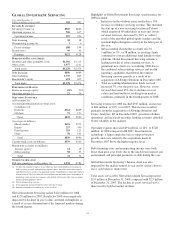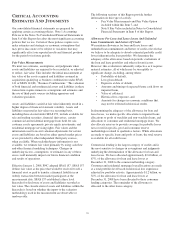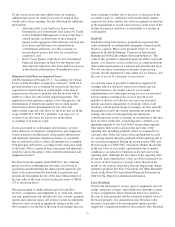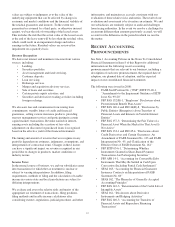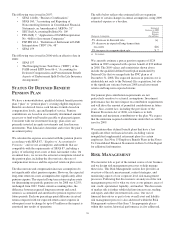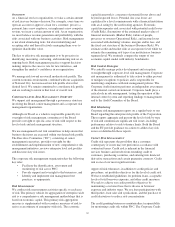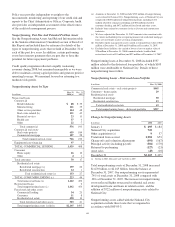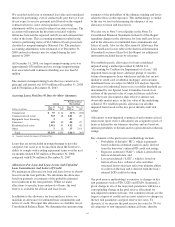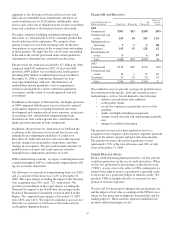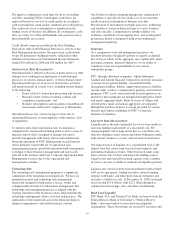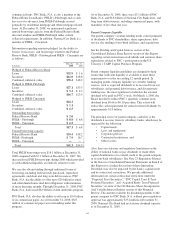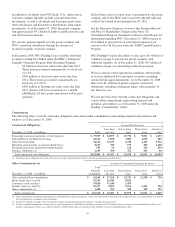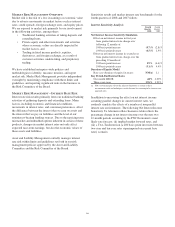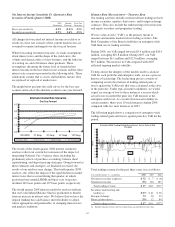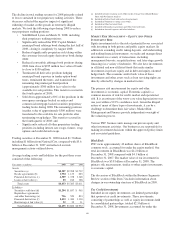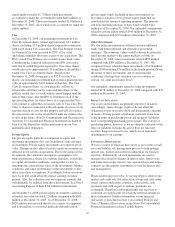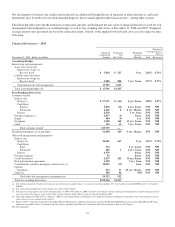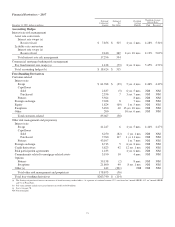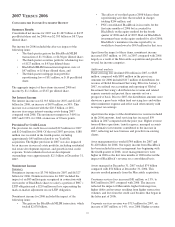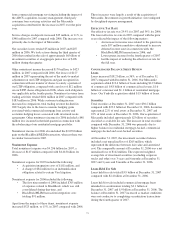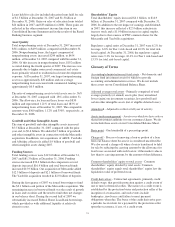PNC Bank 2008 Annual Report Download - page 68
Download and view the complete annual report
Please find page 68 of the 2008 PNC Bank annual report below. You can navigate through the pages in the report by either clicking on the pages listed below, or by using the keyword search tool below to find specific information within the annual report.
commercial loans. PNC Bank, N.A. is also a member of the
Federal Home Loan Bank (“FHLB”)-Pittsburgh and as such
has access to advances from FHLB-Pittsburgh secured
generally by residential mortgage and other mortgage-related
loans. At December 31, 2008, we maintained significant
unused borrowing capacity from the Federal Reserve Bank
discount window and FHLB-Pittsburgh under current
collateral requirements. In addition, National City Bank is a
member of FHLB – Cincinnati.
Information regarding amounts pledged, for the ability to
borrow if necessary, and borrowings related to the Federal
Reserve Bank, FHLB – Pittsburgh and FHLB – Cincinnati are
as follows:
In billions
Dec. 31,
2008
Dec. 31,
2007
Pledged to Federal Reserve Bank
Loans $32.9 $ 1.6
Securities $11.0 $18.8
Combined collateral value $35.4 $18.2
Pledged to FHLB-Pittsburgh
Loans $27.1 $33.5
Securities $ 5.3 $ 4.3
Combined collateral value $16.7 $23.5
Pledged to FHLB-Cincinnati
Loans $22.3
Securities $ 1.1
Combined collateral value $ 6.5
Outstanding borrowings
Federal Reserve Bank $ 2.0
FHLB – Pittsburgh $ 8.8 $ 6.8
FHLB – Cincinnati $ 6.5
Total $17.3 $ 6.8
Unused borrowing capacity
Federal Reserve Bank $33.4 $18.2
FHLB– Pittsburgh $ 7.9 16.7
FHLB – Cincinnati ——
Total $41.3 $34.9
Total FHLB borrowings were $18.1 billion at December 31,
2008 compared with $7.1 billion at December 31, 2007. We
increased total FHLB borrowings during 2008 which provided
us with additional liquidity at relatively attractive rates.
We can also obtain funding through traditional forms of
borrowing, including federal funds purchased, repurchase
agreements, and short and long-term debt issuances. PNC
Bank, N.A. has the ability to offer up to $20 billion in senior
and subordinated unsecured debt obligations with maturities
of more than nine months. Through December 31, 2008, PNC
Bank, N.A. had issued $6.9 billion of debt under this program.
PNC Bank, N.A. also has the ability to offer up to $3.0 billion
of its commercial paper. As of December 31, 2008, $327
million of commercial paper was outstanding under this
program.
As of December 31, 2008, there were $3.1 billion of PNC
Bank, N.A. and $4.8 billion of National City Bank short- and
long-term debt issuances, including commercial paper, with
maturities of less than one year.
Parent Company Liquidity
Our parent company’s routine funding needs consist primarily
of dividends to PNC shareholders, share repurchases, debt
service, the funding of non-bank affiliates, and acquisitions.
See the Funding and Capital Sources section of the
Consolidated Balance Sheet Review section of this Report
regarding certain restrictions on dividends and common share
repurchases related to PNC’s participation in the US
Treasury’s TARP Capital Purchase Program.
Parent company liquidity guidelines are designed to help
ensure that sufficient liquidity is available to meet these
requirements over the succeeding 12-month period. In
managing parent company liquidity we consider funding
sources, such as expected dividends to be received from our
subsidiaries and potential debt issuance, and discretionary
funding uses, the most significant of which is the external
dividend to be paid on PNC’s stock. On March 1, 2009, the
Board decided to reduce PNC’s quarterly common stock
dividend from $0.66 to $0.10 per share. This action will
reduce the cash requirement for annual external dividends by
approximately $1.0 billion.
The principal source of parent company cash flow is the
dividends it receives from its subsidiary banks, which may be
impacted by the following:
• Capital needs,
• Laws and regulations,
• Corporate policies,
• Contractual restrictions, and
• Other factors.
Also, there are statutory and regulatory limitations on the
ability of national banks to pay dividends or make other
capital distributions or to extend credit to the parent company
or its non-bank subsidiaries. See Note 23 Regulatory Matters
in the Notes to Consolidated Financial Statements in Item 8 of
this Report for a further discussion of these limitations.
Dividends may also be impacted by the bank’s capital needs
and by contractual restrictions. We provide additional
information on certain contractual restrictions under the
“Perpetual Trust Securities,” “PNC Capital Trust E Trust
Preferred Securities,” and “Acquired Entity Trust Preferred
Securities” sections of the Off-Balance Sheet Arrangements
And Variable Interest Entities section of this Financial
Review. The amount available for dividend payments to the
parent company by PNC Bank, N.A. without prior regulatory
approval was approximately $351 million at December 31,
2008. National City Bank had no statutory dividend capacity
as of December 31, 2008.
64


